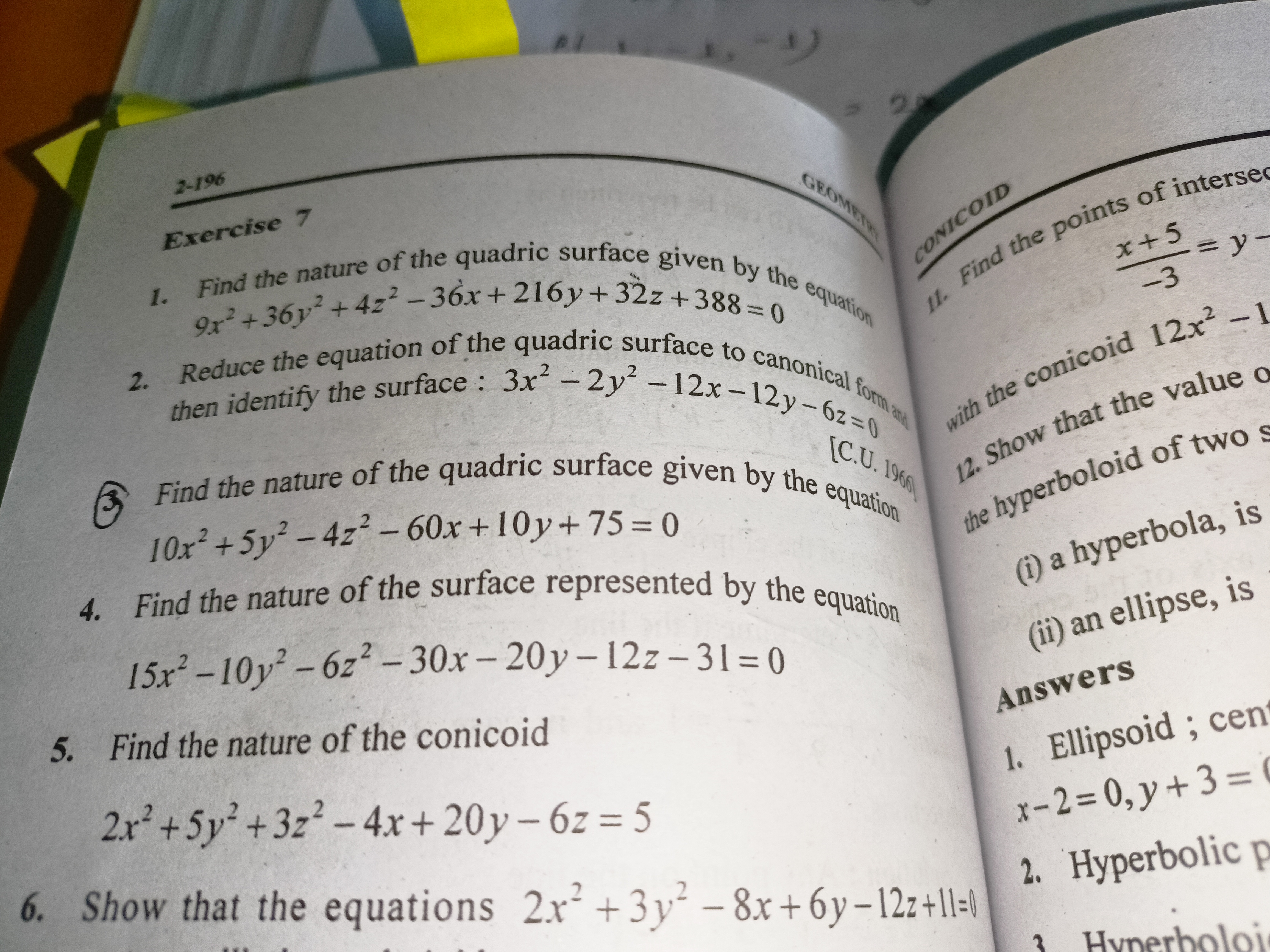Find the nature of the quadric surface given by the equation $10x^2 + 5y^2 - 4z^2 - 60x + 10y + 75 = 0$.

Understand the Problem
The question asks to determine the nature (or type) of the quadric surface defined by the equation $10x^2 + 5y^2 - 4z^2 - 60x + 10y + 75 = 0$. This involves analyzing the equation to classify the surface.
Answer
Hyperboloid of one sheet
Answer for screen readers
Hyperboloid of one sheet
Steps to Solve
- Group like terms
Rearrange the given equation to group the $x$, $y$, and $z$ terms together:
$10x^2 - 60x + 5y^2 + 10y - 4z^2 + 75 = 0$
- Complete the square for $x$ terms
To complete the square for $x$, we need to add and subtract $(60/(2*10))^2 * 10 = 90$ inside the equation:
$10(x^2 - 6x) + 5y^2 + 10y - 4z^2 + 75 = 0$
$10(x^2 - 6x + 9 - 9) + 5y^2 + 10y - 4z^2 + 75 = 0$
$10((x - 3)^2 - 9) + 5y^2 + 10y - 4z^2 + 75 = 0$
$10(x - 3)^2 - 90 + 5y^2 + 10y - 4z^2 + 75 = 0$
$10(x - 3)^2 + 5y^2 + 10y - 4z^2 - 15 = 0$
- Complete the square for $y$ terms
To complete the square for $y$, we need to add and subtract $(10/(2*5))^2 * 5 = 5$ inside the equation:
$10(x - 3)^2 + 5(y^2 + 2y) - 4z^2 - 15 = 0$
$10(x - 3)^2 + 5(y^2 + 2y + 1 - 1) - 4z^2 - 15 = 0$
$10(x - 3)^2 + 5((y + 1)^2 - 1) - 4z^2 - 15 = 0$
$10(x - 3)^2 + 5(y + 1)^2 - 5 - 4z^2 - 15 = 0$
$10(x - 3)^2 + 5(y + 1)^2 - 4z^2 - 20 = 0$
- Rearrange the equation
Move the constant to the right side:
$10(x - 3)^2 + 5(y + 1)^2 - 4z^2 = 20$
- Divide by the constant to standardize
Divide both sides by 20 to get 1 on the right side:
$\frac{10(x - 3)^2}{20} + \frac{5(y + 1)^2}{20} - \frac{4z^2}{20} = 1$
$\frac{(x - 3)^2}{2} + \frac{(y + 1)^2}{4} - \frac{z^2}{5} = 1$
- Identify the quadric surface
The equation is now in the standard form of a quadric surface. Since we have two positive terms and one negative term on the left side of the equation, it represents a hyperboloid of one sheet.
Hyperboloid of one sheet
More Information
A hyperboloid of one sheet is a quadric surface that can be visualized as a curved surface that opens outwards along one axis while being continuous and connected. It has elliptical cross-sections perpendicular to one axis and hyperbolic cross-sections parallel to planes containing that axis.
Tips
A common mistake is to incorrectly complete the square or misinterpret the signs of the terms, leading to the wrong classification of the quadric surface. For example, if the equation ended up with all positive terms, it would have been an ellipsoid. Another common mistake is not dividing by the constant term to get the standard form of the quadric surface equation, which makes it difficult to correctly identify the surface.
AI-generated content may contain errors. Please verify critical information